AMD at COMPUTEX 2025: RX 9060 XT, Threadripper 9000, and Radeon PRO
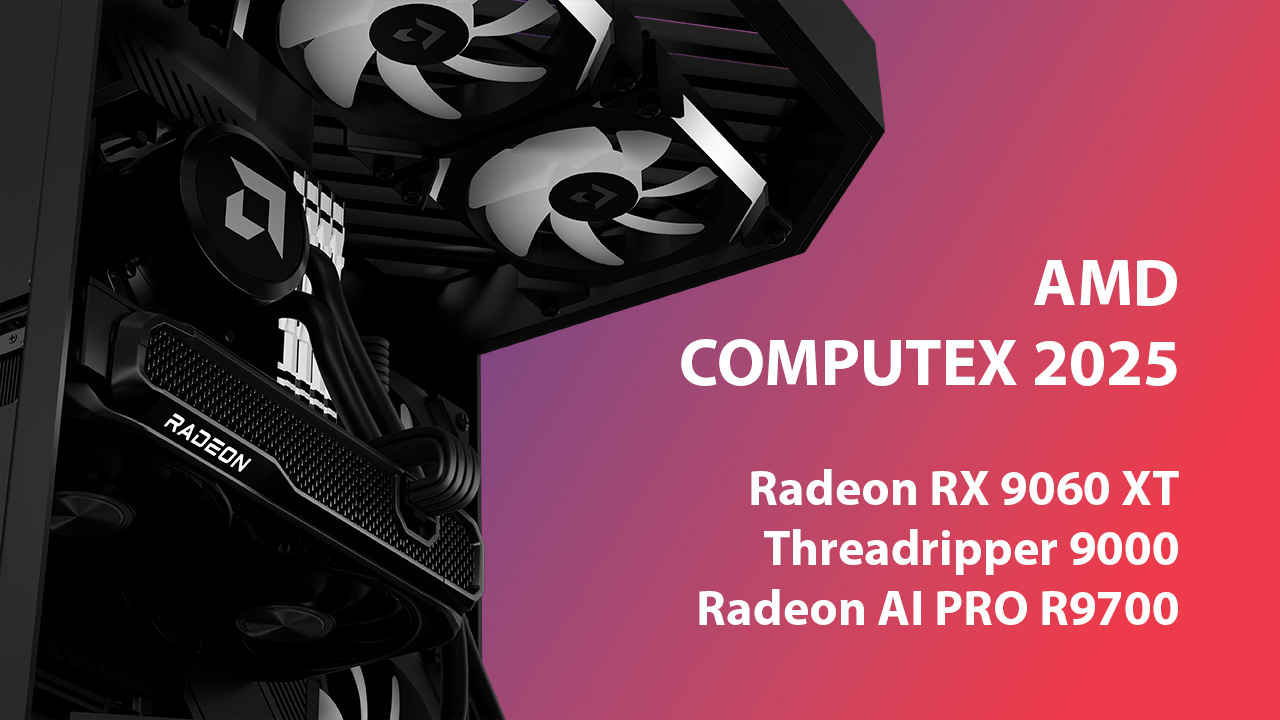
AMD’s COMPUTEX 2025 press conference wasn’t about subtle nudges or incremental upgrades. It was a triple-barrelled launch, aimed squarely at gamers, creators, and AI professionals. The company revealed the Radeon RX 9060 XT for next-gen gaming, the Ryzen Threadripper 9000 series for extreme desktop workloads, and the Radeon AI PRO R9700 to stake a serious claim in the professional AI compute space. Here’s everything you need to know from the press conference.
 Survey
SurveyRadeon RX 9060 XT – RDNA 4 for the masses
Let’s start with what most gamers will care about—the Radeon RX 9060 XT. This is AMD’s volume play for the RDNA 4 architecture, and while it’s not a flagship SKU, it’s positioned to be the new mainstream hero. Featuring 32 compute units which results in 32 ray accelerators, the 9060 XT claims to double the ray tracing throughput of its predecessor, and it includes support for FP8 data types and structured sparsity, this card is designed with both traditional gaming and AI-enhanced experiences in mind.
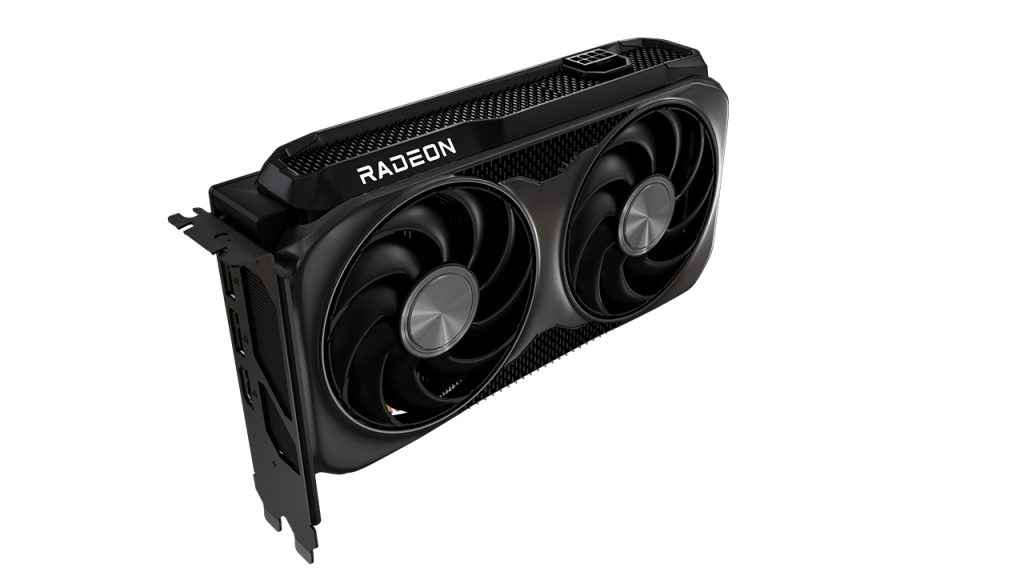
AMD is clearly betting that future games will increasingly rely on AI workloads—be it for procedural content generation, real-time upscaling, or dynamic worldbuilding. That’s where support for structured sparsity and FP8 comes in. It’s also part of a broader push to make GPUs useful beyond just pixels—something NVIDIA has been doing for years.
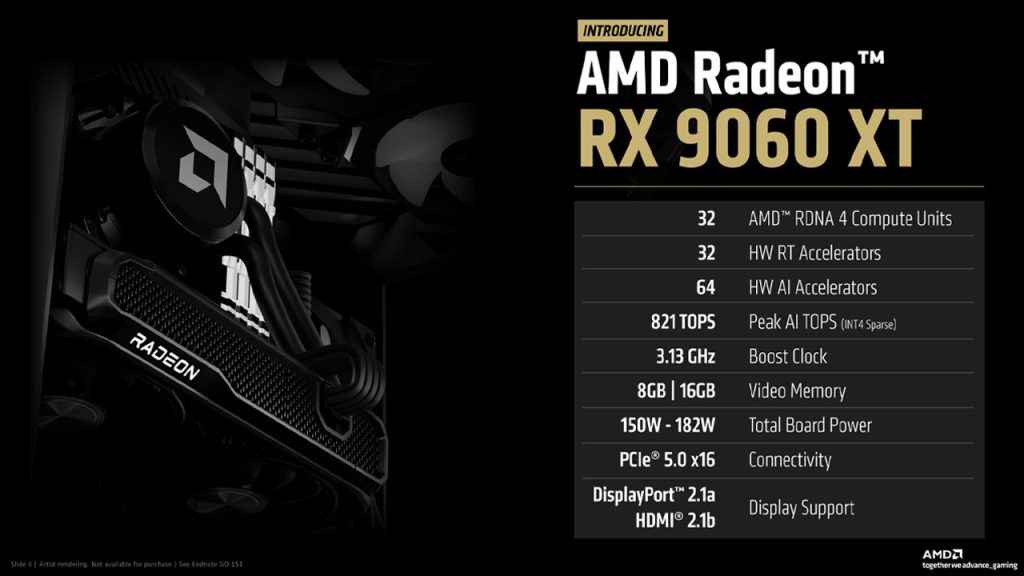
In terms of memory, the 9060 XT comes in two variants, one with 8 GB of GDDR6 VRAM and another with 16 GB of GDDR6. AMD didn’t share detailed frame-rate numbers just yet, but it did say that the 9060 XT is aimed at gamers who want to “max settings” today’s titles and be ready for tomorrow’s. With DisplayPort 2.1, AV1 encode/decode, and second-gen ray accelerators, it seems like a solid update for anyone still holding on to an RX 6000 series GPU. Availability is expected later this summer, and the 9060 XT 16 GB variant will retail for USD 349 while the 9060 XT 8 GB variant will retail for USD 299. The 9060 XT will only be available as board partner cards.
FSR Redstone – Neural Fidelity joins the fFray
Alongside the RX 9060 XT, AMD also offered a glimpse into the next step for FidelityFX Super Resolution—tentatively titled FSR Redstone. While it’s unclear whether this will be classified as FSR 4.x or earn its own version number entirely, the capabilities signal a significant leap forward for AMD’s image reconstruction suite.
FSR Redstone introduces three key features that bring AMD closer to feature parity with NVIDIA’s DLSS stack: Neural Radiance Caching, Machine Learning Ray Regeneration, and Machine Learning Frame Generation. All three rely on ML inference, something AMD’s newer GPU architectures are increasingly equipped to handle thanks to their updated AI accelerators and FP8 capabilities.
Neural Radiance Caching is particularly notable, as it enables more physically accurate indirect lighting and reflections—mirroring what DLSS 3.5’s Ray Reconstruction aims to deliver. Similarly, the machine learning-driven Frame Generation looks to offer smoother gameplay experiences, particularly in CPU-bound scenarios.
What’s impressive is the pace. FSR 4 only launched in March 2025, and yet Redstone’s features are already being previewed. AMD also shared adoption stats for FSR 4—launched with 30 supported games in March, it’s expected to double that number to 60 titles by June 5th.
This is a promising sign that developers are responding well to AMD’s open approach, and that the ecosystem around FSR is maturing faster than many expected.
Ryzen Threadripper 9000 – Zen 5 hits the workstation
Threadripper is back, and it’s had quite an upgrade. Now based on AMD’s Zen 5 architecture, the Ryzen Threadripper 9000 family is going to be available as the consumer-grade 9000 series and the workstation-focused PRO 9000 WX series.
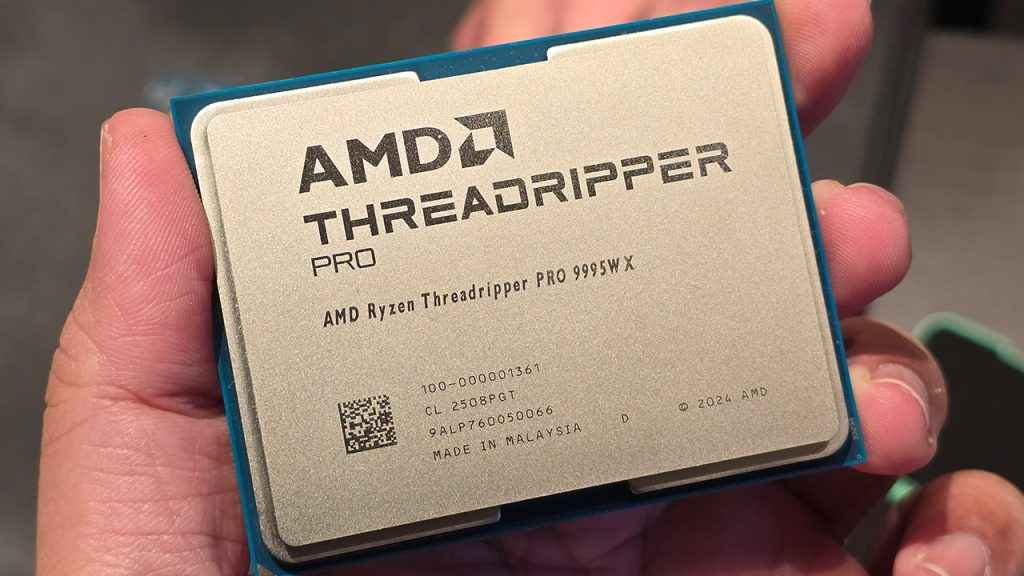
The Ryzen Threadripper PRO 9995WX, sporting a jaw-dropping 96 cores and 192 threads which is the same as the Threadripper 7000 series’ flagship SKU. It’s targeted at professionals working in architecture, media and entertainment, AI research, and anyone else who can benefit from obscene levels of parallelism. These chips support eight channels of DDR5 memory, offer vast PCIe Gen 5 lane counts, and are designed to live in systems with high uptime and remote manageability.
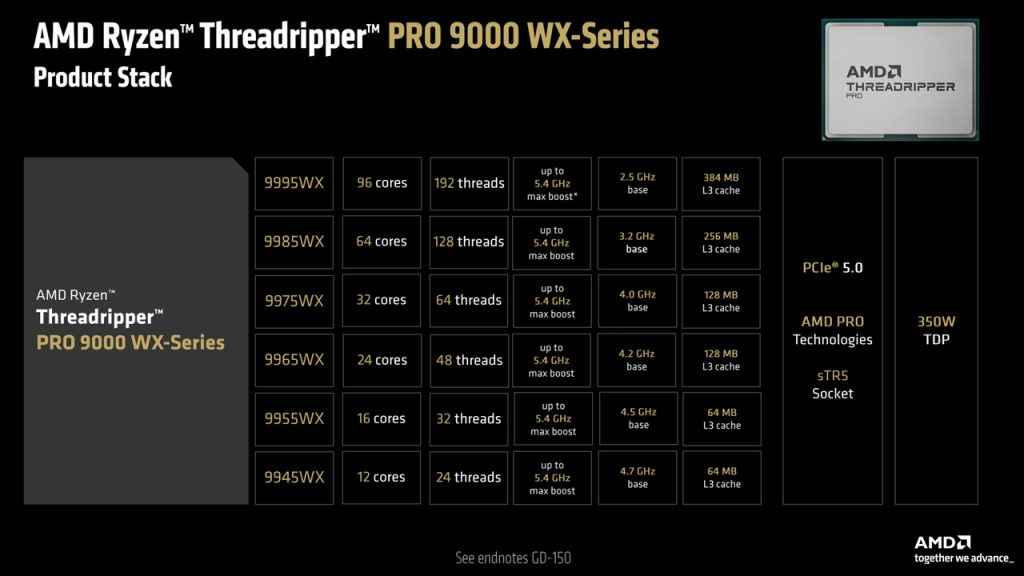
The PRO chips also come with AMD PRO Technologies—meaning enterprise-grade security, remote fleet management, and guaranteed platform stability. These are the kind of features that IT admins obsess over but DIY users probably don’t care much about. That’s where the Threadripper 9000 non-PRO chips come in. At the top of that stack is the 9980X, which has 64 cores and 128 threads. It drops the enterprise features, but keeps the brute force performance—making it ideal for software developers, 3D artists, and anyone compiling huge codebases or doing local AI model training on a single box.
From what we’ve seen so far, Zen 5 delivers not only higher performance-per-watt, but also better latency scaling across cores, which should make these chips more responsive under mixed workloads.
Radeon AI PRO R9700 – AMD goes all-in on workstation AI
The third important announcement is the Radeon AI PRO R9700—a GPU designed specifically for AI workstations, not gaming. The R9700 packs 128 AI accelerators and 32GB of GDDR6 memory, backed by a PCIe Gen 5 interface and a 300W TDP. It’s meant to live in high-end workstations that handle tasks like large-language model development, model fine-tuning, and on-device inference. It features the same chip as the consumer grade graphics card with more bells and whistles switch on.
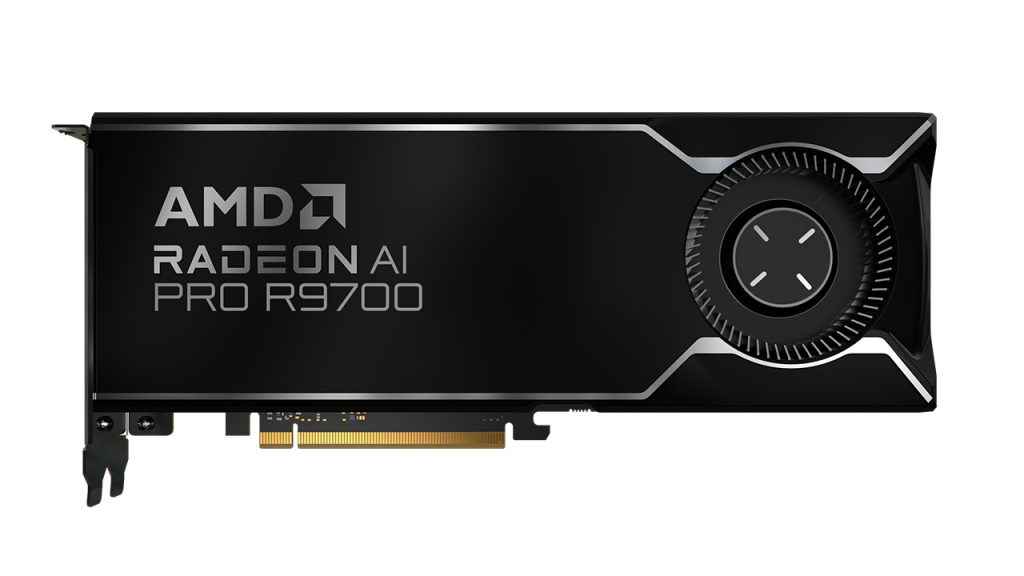
According to AMD, the R9700 offers up to 4X the AI accelerator throughput compared to its predecessor, the Radeon PRO W7800. Benchmarks shown during the keynote revealed significant performance gains on models like DeepSeek R1, Mistral Small, and Qwen 32B, with throughput improvements between 360–496% depending on the workload. AMD even took a swipe at NVIDIA’s RTX 5080, claiming better performance across large prompt sizes thanks to its 32GB memory buffer.
Importantly, the R9700 supports ROCm on Linux at launch, with Windows support coming soon. It also scales well in multi-GPU configurations—a nod to the growing need for local compute infrastructure in AI labs and creative studios alike. For industries looking to keep AI workloads on-prem for reasons of privacy, cost, or latency, the Radeon AI PRO R9700 looks to be a compelling option. General availability begins in July 2025.
Copilot+ PCs and Ryzen AI
While not the headline, AMD also used its time on stage to talk up the Ryzen AI 300 series and their integration into ASUS’ upcoming Expert P series of commercial notebooks. These Copilot+ PCs feature up to 50+ TOPS of NPU performance and full AMD PRO Technologies support. They’re aimed at professionals who want local AI capabilities without sacrificing manageability or security.
AMD is a tough competitor
Whether you’re a gamer, a creator, a data scientist, or a business IT manager, AMD wants to power your next machine—be it with GPUs tuned for ray tracing and AI-assisted gameplay, CPUs packing dozens of cores, or workstation cards designed to crunch through massive AI models. NVIDIA may still dominate the AI discourse, but AMD is clearly pushing hard to widen the narrative—and this year’s announcements show it’s not just about catching up, but carving its own lane.
Computex 2025 is running from Tuesday, May 20 to Friday, May 23, 2025 and Digit will be on ground covering COMPUTEX 2025. Head to Digit’s Computex 2025 Hub to see the latest announcements from COMPUTEX as they happen.
Mithun Mohandas
Mithun Mohandas is an Indian technology journalist with 14 years of experience covering consumer technology. He is currently employed at Digit in the capacity of a Managing Editor. Mithun has a background in Computer Engineering and was an active member of the IEEE during his college days. He has a penchant for digging deep into unravelling what makes a device tick. If there's a transistor in it, Mithun's probably going to rip it apart till he finds it. At Digit, he covers processors, graphics cards, storage media, displays and networking devices aside from anything developer related. As an avid PC gamer, he prefers RTS and FPS titles, and can be quite competitive in a race to the finish line. He only gets consoles for the exclusives. He can be seen playing Valorant, World of Tanks, HITMAN and the occasional Age of Empires or being the voice behind hundreds of Digit videos. View Full Profile